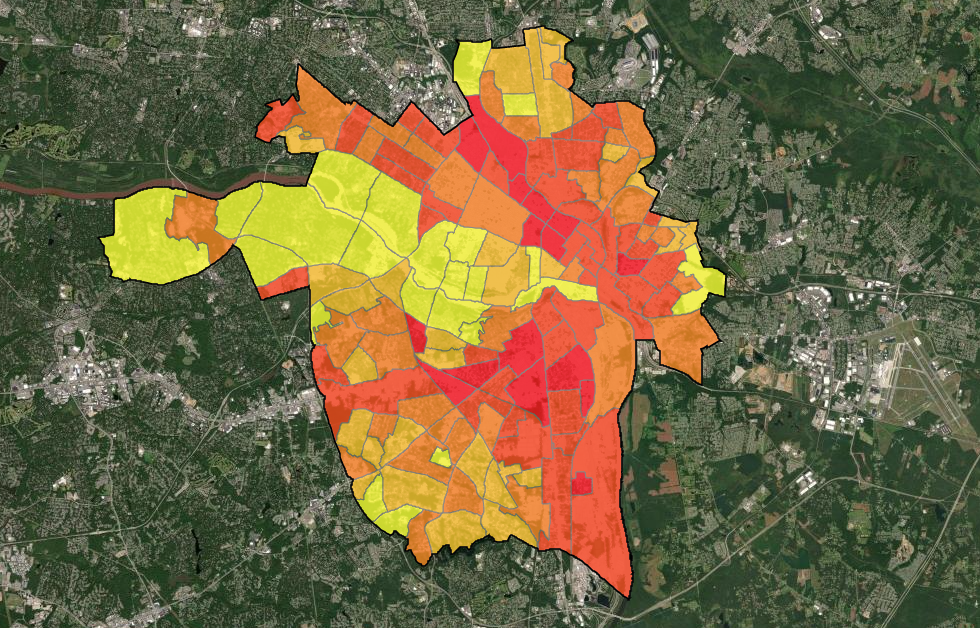RICHMOND, Va. -- As a heat wave smothers Richmond, some parts of the city are feeling the impacts of it more than others.
The reason for that is known as the urban heat island effect where cities are hotter than rural areas and parts of the city are warmer than others. This is due to fewer trees and more non-permeable infrastructure.
"Because there are fewer trees, the surfaces tend to absorb more heat and they also tend to be pavement that the water hits and runs off. So, the cooling effects of water are less prevalent," said Todd Lookingbill, the Department Chair and Associate Professor of Geography and the Environment, University of Richmond.
Lookingbill has studied the issues for several years including leading a statewide survey in 2021 that studied the effect in ten cities around Virginia to measure temperature disparities, including Richmond.
Lookingbill discussed the findings of the survey in April.
"We saw about a 10 degree difference in Richmond in July 15, 2021," Lookingbill added. He said they also compared the findings to an initial study done in 2017. "Something that maybe we didn't expect to find was that in 2017, overall, that day was a little bit warmer — the temperature rose to 102 degrees in 2017. And what we found was the disparity between hottest and coolest areas was greater when the temperature is higher. So in 2017, it was a little bit hotter day and...we had a 15 degree difference in temperature. In 2021, we had a 10 degree difference in temperature for a little bit cooler day. So that suggests as we get warmer and warmer temperatures, this disparity is going to get worse and worse."
Among the hottest spots in Richmond were Scotts Addition and several on the Southside where Lookingbill said they saw some of the greatest disparities.
"In the western part of the city, we have some of the coolest neighborhoods and on the eastern part of the city, we have some of the warmest neighborhoods," Lookingbill said.
The university created an interactive map where you can look at the results of the survey.

Studies have also found that those neighborhoods also have similarities to the practice of redlining in the 1930s where federal banking regulators deemed minority neighborhoods to be risky and made getting loans difficult.
Lookingbill said ways to mitigate this include planting more trees and creating more parks.
"We have about 6% of the city designated as parks and recreations and the national average is 15%," Lookingbill said.
Lookingbill said their data is helping guide city efforts to address the issue, including the creation of more parks on the city's Southside.
The city also has initiatives included in its Richmond 300 plan (including increasing the tree canopy in the city from -- and RVAgreen 2050, which is developing a Community Equity Action Plan.
Lookingbill said there are also many non-profits dedicated to improving the city's green infrastructure. Rob Jones' Groundwork RVA is among them.
"It's very much a resource and zip code issue. And we're working hard to try and focus our work in the zip codes were people don't and can't manage it for themselves," Jones said.
Jones said his group is a youth development organization focused in the environmental and environmental justice space has three main programs: a bike shop that serves elementary school kids, a high school-based program that provides environmental training and summer jobs, and a workforce program that plants and maintains
"To make the tree canopy for the city better so that there's more shade and less stormwater runoff," said Jones.
Among what the group does is plant and maintain trees. While Jones said what the city has laid out is good in theory, there is still a way to go.
"In order for them to be implemented requires changes to zoning and changes to ordinances that city council has to make and hasn't made," Jones said.
Jones and Sheri Shannon with Southside ReLeaf say along with adding green space, the city needs to preserve what it already has.
"We're not seeing the great infrastructure also coming with the green infrastructure," Shannon said.
The pair said they support development but want more efforts to encourage developers to keep what old growth they can.
They point to a recent example in Manchester that once was trees and a community garden but has been removed.
"This probably obviated half of the work of tree planting that we've done over the last two years, right? Because little trees don't do as much as big trees, big trees do more," Jones said.
The city's 300 plan does mention developing education and incentive programs to get private owners to care for existing trees.
CBS 6 has asked for a timeline on this but we had not heard back as of Friday at 6 p.m.






